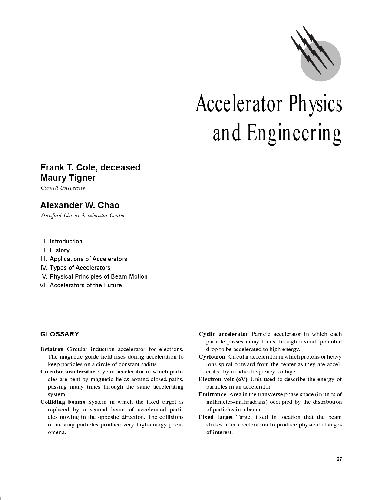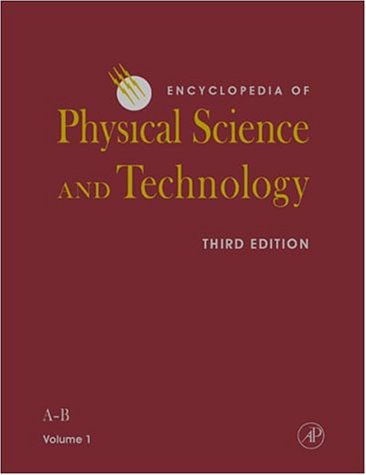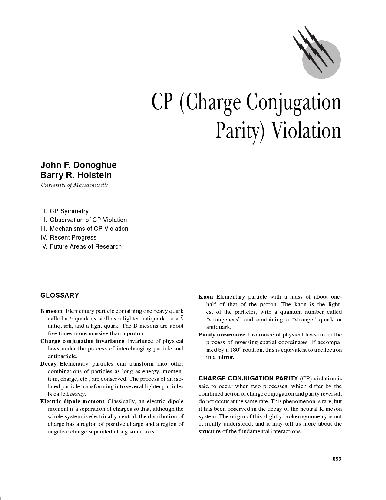Robert Allen Meyers (Editor)9780122274107
Table of contents :
Glossary……Page 1
Parameters Characterizing the Beam……Page 2
Accelerator Technology……Page 3
History……Page 4
Household Appliances……Page 6
High-Energy and Nuclear Physics……Page 7
Medical Accelerators……Page 8
Chemistry……Page 9
Voltage Multiplying Devices……Page 10
Linear Accelerators……Page 11
Electron Linac……Page 12
Cyclotron……Page 13
Microtron……Page 14
New Concepts……Page 15
Circular Accelerators……Page 16
Weak Focusing……Page 17
Betatron Oscillation……Page 18
Synchrotron Lattice……Page 19
Longitudinal Stability and Acceleration……Page 20
Phase Oscillation……Page 22
Effects on Focusing……Page 23
Electron Cooling……Page 24
Circular Accelerators……Page 25
Novel Acceleration Methods……Page 26
References……Page 27
Glossary……Page 28
Cross Section Defined……Page 29
Formulation……Page 30
Reaction Cross Sections……Page 32
Impulse Approximation……Page 33
The Scattering Amplitude……Page 35
Semiclassical Cross Section……Page 36
Other Approximations……Page 37
Overview……Page 38
Long-Range Interactions……Page 39
Intermediate Range Potentials and Charge Exchange……Page 40
Classical Oscillator……Page 43
Bethe–Born……Page 44
Two-State Models: Charge Exchange……Page 45
Detailed Balance……Page 48
Time-Dependent Approach……Page 49
References……Page 50
Glossary……Page 52
Historical Development……Page 53
The Hydrogen Atom……Page 57
The Helium Atom……Page 60
Rydberg and Exotic Atoms……Page 62
Complex Atoms……Page 63
Interaction of Atoms With Radiation……Page 67
References……Page 69
Glossary……Page 71
What Is a Collider?……Page 72
Why Colliders?……Page 73
Solid-State Detectors……Page 74
Gaseous Detectors……Page 76
Electromagnetic Calorimeters……Page 77
Calorimeter Optimization……Page 78
Performance Limits of Detectors……Page 79
Experience and Emotion: Design Driven by Physicists……Page 80
Number of Detection Cells……Page 82
Engineering Complexity……Page 83
Constructing a Collider Detector……Page 84
Closing Remarks……Page 85
References……Page 86
Glossary……Page 87
A Discovery……Page 88
Mixtures……Page 89
Molecular Gases……Page 90
Rotovibrational Spectra……Page 91
Mixtures of Gases……Page 92
Infrared-Active Gases……Page 93
Charged Systems……Page 95
Collision-Induced Dipoles……Page 96
Ternary Dipoles……Page 97
Collision-Induced Light Scattering……Page 98
Collision-Induced Polarizabilities……Page 99
Other Virial Expansions……Page 100
Dielectric and Refractive Virial Expansions……Page 101
Atmospheric Sciences……Page 102
Applied Sciences……Page 103
Conclusions……Page 104
References……Page 105
Glossary……Page 106
Introduction……Page 107
General Considerations……Page 108
Ordinary Time-Dependent Perturbation Theory……Page 109
Green’s Function (Resolvent) Method……Page 110
Density Matrix Method……Page 111
Susceptibility Method……Page 112
Direct Method for Solving the Time-Dependent Schrödinger Equation……Page 113
Measurement of the Photon Absorption Due to a Two-Photon Absorption Process……Page 114
Detection of Fluorescence after Two-Photon Excitation of Molecules……Page 115
Ion Detection in a Mass Spectrometer……Page 116
Miscellaneous Detection Methods……Page 117
Doppler-Free Multiphoton Spectroscopy……Page 118
Perturbative Regime—Formal Intensity Law……Page 119
Polarization Behavior……Page 120
Polarization Behavior of Nonrotating Molecules……Page 121
Polarization Behavior of Rotating Molecules……Page 124
Spectral Properties of Multiphoton Transitions……Page 125
Vibronic Coupling in Molecular Two-Photon Transitions……Page 126
Evolution from Multiphoton Ionization to Tunnel Ionization for Atoms and Molecules……Page 127
Doppler-Free Multiphoton Transitions in Atoms and Molecules……Page 128
Low-Lying Electronic Excited States (1Ag) of Linear Polyenes……Page 130
Above-Threshold Ionization of Atoms……Page 131
Multiphoton Ionization Mass Spectroscopy……Page 132
Femtosecond Multiphoton Spectroscopy……Page 133
High-Order Harmonic Generation……Page 134
Nonsequential Multiple Ionization of Atoms……Page 135
References……Page 136
Glossary……Page 137
Sources of Vuv Radiation……Page 138
Nature of Excited Electronic States Populated by Absorption at Vuv Photon Energies……Page 139
Possible Fates of a Molecule Following Excitation With a Vuv Photon……Page 140
Methods for Studying Vuv Photochemistry……Page 142
Resonance-Enhanced Multiphoton Ionization (REMPI)……Page 143
Photofragment Excitation (PHOFEX) Spectroscopy……Page 144
Photofragment Translational Spectroscopy (PTS) and Ion Imaging……Page 145
References……Page 149
Glossary……Page 151
Electromagnetic Radiation……Page 152
Interaction of Radiation With Matter……Page 154
Photodissociation……Page 157
Radiationless Decay……Page 160
Time-Dependent Perspective……Page 161
Internal Conversion and Intersystem Crossing……Page 162
Photoinitiated Unimolecular Decomposition……Page 164
Standard Statistical Models……Page 165
Vibrational Photochemistry……Page 166
Loose versus Tight Transition States……Page 167
References……Page 168
Glossary……Page 170
Description of Radiation Physics……Page 172
Photons……Page 173
Protons……Page 174
Neutrons……Page 175
General……Page 176
Electrons……Page 177
Photons……Page 178
Protons……Page 179
Cosmic Rays……Page 180
Transient Ionization Effects……Page 181
Gases……Page 182
Semiconductors……Page 183
Insulators……Page 184
Charge Transfer……Page 185
Effects on Electronic Devices and Circuits……Page 186
Mechanisms……Page 187
Semiconductor Devices……Page 188
Optical Materials and Oxides……Page 193
Simple Defects……Page 194
Defect Clusters……Page 195
Scaling Displacement Effects for Different Exposures……Page 196
Single-Event Phenomena……Page 198
The Problem……Page 200
Shielding……Page 202
Special Uses of Radiation……Page 203
Radiotracers……Page 204
References……Page 205
Glossary……Page 207
Scattering and Recoiling Anisotropy……Page 208
TOF-SARS System……Page 209
BS versus Incident Angle α Scans……Page 211
BS versus α Scans with Adsorbates……Page 212
R versus α Scans……Page 213
Elemental Analysis……Page 214
Ion–Surface Electron-Exchange Probabilities……Page 215
References……Page 216
Glossary……Page 217
Stimulated emission…….Page 218
Numerical Determinations……Page 219
The “Branching Ratio” Technique……Page 221
Absorption and “Hook” Techniques……Page 222
The beam-laser technique……Page 223
Atomic Structure Theory……Page 224
Regularitiexs in Oscillator Strengths: f-Sum Rules……Page 225
References……Page 226
Glossary……Page 227
The Phenomenon and its Physical Basis……Page 228
General Types of Scattering Patterns……Page 229
The Limiting Cases of Dilute and Densely Packed Systems……Page 230
Mean Square Fluctuation of the Electron Density……Page 231
Intersection Length……Page 232
Quantitative Calculation of Particle Scattering……Page 233
Concentration effect……Page 234
Rodlike particles, radius of gyration of the cross section Rc……Page 235
Lamellar particles: Radius of gyration of the thickness Rt……Page 236
Parallelepipedic particles……Page 237
Mass per unit length for rodlike particles……Page 238
Electron density distribution of symmetrical particles……Page 239
Approximation by simple triaxial bodies……Page 241
Models composed of many spheres that do not represent chemical subunits……Page 242
Comparison of the experimental and theoretical distance distribution functions……Page 243
Distance determination with X-rays by heavyatom labeling……Page 245
Differential contrast matching……Page 246
Evaluation of the contrast dependence of the radius of gyration……Page 247
Label triangulation method for the evaluation of quarternary structures……Page 248
Time-Resolved X-Ray Small-Angle Scattering with Synchrotron Radiation……Page 249
Special Features of the Scattering Curve……Page 251
Cellulose nitrate……Page 253
Chain Conformation Analysis by the Use of Markers……Page 254
Amorphous Densely Packed Systems: Chain Conformation Analysis by Markers……Page 255
Sample preparation……Page 256
Micellar Shape from Studies on Stretched and Rolled Solid Cellulose……Page 257
Longitudinal Periodicity in Cellulose Fibers……Page 258
Pore Analysis……Page 260
Synthetic High Polymers in the Solid State……Page 261
Introduction to the Quantitative Treatment of the Lamellar Stack Model……Page 262
Physical Metallurgy……Page 264
Catalysts……Page 265
Critical Scattering in Liquids……Page 266
Synchrotron Radiation……Page 267
Beeman Camera……Page 268
Overall construction of the camera……Page 269
Monochromatization……Page 270
Absolute Intensity……Page 271
Scattering from Fractal Objects……Page 272
Oligo- and Multilayers……Page 275
References……Page 276







Reviews
There are no reviews yet.